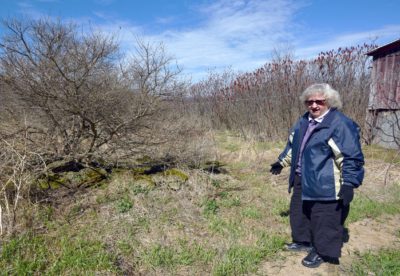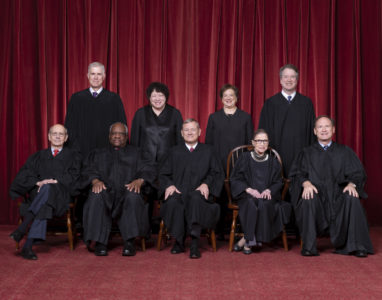Supreme Court Takes a Knick Out of Regulatory Takings Law
Justices Curb Ripeness Rule; Open Federal Courts to Takings Litigation
In the final, major environmental law decision of its current Term, the U.S. Supreme Court handed property rights advocates a major victory while repudiating an important regulatory takings precedent the Court had itself fashioned and announced 34 years ago.
The case is Knick v. Township of Scott. By a narrow 5-4 vote that split along ideological lines, the Court in Knick overruled a key component of the justices’ controversial “ripeness” doctrine, which for decades has limited the ability of property owners to pursue their regulatory takings claims in federal (as opposed to state) courts.
A bit of regulatory takings history is helpful at this point: in the early and mid-1980’s, the Supreme Court struggled mightily to decide the distinct question of whether money damages are a constitutionally-compelled remedy for a regulatory taking of private property. Beginning in 1980, the justices attempted for eight successive Terms to resolve that issue, only to find that procedural deficiencies in the first seven cases prevented them from resolving the question. (The Court finally ruled in 1987 that damages are a constitutionally-mandated remedy for a regulatory taking in First English Evangelical Church of Glendale v. County of Los Angeles.)
In the process, however, the justices created–pretty much out of whole judicial cloth–an important set of procedural rules known as the ripeness doctrine, dictating when and where takings plaintiffs can pursue their regulatory takings lawsuits. In Williamson County Regional Planning Commission v. Hamilton Bank, the justices in 1985 ruled that a takings plaintiff cannot bring a regulatory takings claim in federal court until s/he has : 1) obtained a final decision from the regulatory agency regarding the application of the challenged regulation to the property at issue; and 2) attempted to obtain compensation from the government through available state administrative and court remedies. It’s the second prong of the Williamson County ripeness doctrine that the Supreme Court revisited and ultimately abandoned in Knick.
Williamson County’s ripeness rule quickly drew the ire of property rights advocates, who much prefer to pursue their regulatory takings claims in federal court. Their protests grew even louder as the result of the Supreme Court’s 2005 decision in San Remo Hotel L.P. v. City & County of San Francisco; that case held that a state court’s regulatory takings decision precludes a property owner’s later pursuit of the same constitutional claim in federal court. Over the years, several past and current justices expressed in various concurring and dissenting opinions their growing discomfort with the Court’s Williamson County state-litigation rule.
The Knick decision arose from humble facts: Rose Mary Knick owns a 90-acre rural property in the Township of Scott, in western Pennsylvania. Her parcel contains a small family graveyard. The Township passed an ordinance requiring that all cemeteries be made accessible to the general public during daylight hours, and notified Knick that she was in violation of its ordinance. Knick responded by filing an inverse condemnation lawsuit against the Township in state court, which declined to grant the injunctive relief she sought. Knick, represented by the Pacific Legal Foundation, then re-filed her lawsuit in federal court, this time seeking money damages for the claimed regulatory taking of her property.
The district court, citing Williamson County, dismissed her federal lawsuit for failure to pursue her monetary remedy under the Takings Clause in state court, and the U.S. Court of Appeals affirmed. The Supreme Court then granted certiorari, squarely framing the issue presented as whether the second prong of Williamson County‘s ripeness rule should be overruled. (The first prong of the rule–that takings plaintiffs must seek and obtain a final administrative decision regarding the application of the challenged regulation to the affected property–was not challenged or at issue in Knick.)
It’s at that point that things got especially interesting. The Knick case was initially argued in the first week of the Court’s 2018-19 Term, in early October, with only eight justices then on the bench. It quickly became apparent from the justices’ questions and comments that they were ideologically split 4-4 on the question presented, with the progressive wing of the Court prepared to uphold the Williamson County ripeness rule while the conservative wing appeared ready to jettison it. So it was not particularly surprising that the Court ordered the case be reargued once Justice Brett Kavanaugh was confirmed by the U.S. Senate and sitting on the Court. The second Supreme Court argument in Knick, with a full complement of nine justices sitting, was held on January 16th.
The Court issued its decision in Knick on June 21st. The majority opinion, authored by Chief Justice Roberts, was joined by Justices Thomas, Alito, Gorsuch and–critically–Kavanaugh. Chief Justice Roberts’ opinion concludes “that [Williamson County‘s] state-litigation requirement imposes an unjustifiable burden on takings plaintiffs, conflicts with the rest of our takings jurisprudence, and must be overruled.”
Roberts’ opinion predicates the perceived need to overrule Williamson County on what he views as that precedent’s fundamental unfairness to property owners:
“The takings plaintiff…finds himself in a Catch-22: He cannot go to federal court without going to state court first; but if he goes to state court and loses, his claim will be barred in federal court. The federal claim dies aborning…[T]he state-litigation requirement rests on a mistaken view of the Fifth Amendment”
Decrying the “unintended consequences” of Williamson County, Roberts opines in Knick that “[t]he state-litigation requirement relegates the Takings Clause `to the status of a poor relation’ among the provisions of the Bill of Rights.”
Chief Justice Roberts, eschewing his normally dispassionate writing style, is especially colorful in castigating the Court’s longstanding ripeness rule: “Williamson County was not just wrong. Its reasoning was exceptionally ill founded…[T]he state-litigation requirement has been a rule in search of a justification for over 30 years.” Notably, he faults the U.S. Solicitor General (who appeared as an amicus in both Williamson County and Knick) for first advancing the state-litigation rule the Court ultimately adopted in Williamson County, and continuing to defend its validity in Knick.
 Justice Kagan authored a vigorous and lengthy dissent, in which Justices Breyer, Ginsburg and Sotomayor joined. She defends Williamson County as fully “rooted in an understanding of the Fifth Amendment’s Takings Clause stretching back to the late 1800s.”
Justice Kagan authored a vigorous and lengthy dissent, in which Justices Breyer, Ginsburg and Sotomayor joined. She defends Williamson County as fully “rooted in an understanding of the Fifth Amendment’s Takings Clause stretching back to the late 1800s.”
The most compelling point in Kagan’s dissent is that Knick’s “consequence is to channel a mass of quintessentially local cases involving complex state-law issues into federal courts.” In the process, she protests, the majority’s ruling “will subvert important principles of judicial federalism.”
Finally, Kagan castigates the majority for failing to observe the principle of stare decisis by overruling Williamson County. She observes in her dissent that that’s especially problematic because Congress has the power to address the problem perceived by the majority, but has refrained from doing so over the past 34 years.
To be sure, the Court’s decision in Knick is a major win for property owners and their libertarian supporters. And Justice Kagan is undoubtedly correct that Knick will trigger a flood of land use takings litigation in the federal courts, where federal judges will be required to parse local zoning ordinances, state property rules, etc., with which they’re likely to be unfamiliar.
Knick’s impact on taking defendants, by contrast, will be uneven. State governments will be largely immune from its holding, since they can continue to assert their immunity under the Eleventh Amendment from unconsented lawsuits seeking damages in federal court. But local and regional governments will find themselves increasingly having to defend their regulatory programs against takings litigation brought in federal court, which have traditionally been more sympathetic to such lawsuits than their state court counterparts.
More broadly, the question arises whether Knick is simply the leading edge of a new property rights renaissance in the U.S. Supreme Court. With a five-member majority of conservative justices now firmly in place, the Court may prove increasingly sympathetic to the claims of property owners and the regulated community–and, conversely, increasingly skeptical of the regulatory programs administered by local, state and federal governments.
Reader Comments
One Reply to “Supreme Court Takes a Knick Out of Regulatory Takings Law”
Comments are closed.






The Knick decision appears to be a wolf in sheep’s clothing. While the sweet, elderly, rural property owner with a family graveyard may be a very sympathetic plaintiff, this case has potentially broad application to other property owners such as businesses that care more about short term profits than the public interest, the environment, or even their own sustainability.
For example, after decades of private groundwater overexploitation and mismanagement, California recently passed a series of bills known as the Sustainable Groundwater Management Act (SGMA), which requires local agencies called Groundwater Sustainability Agencies (GSAs) to develop Groundwater Sustainability Plans (GSPs) to mitigate overdrafting and subsidence of groundwater basins. If GSAs exercise their authority in a responsible manner, they must curtail overuse of water by property owners who are not concerned with sustainability or the public interest. This conflict may lead to litigation under the guise of “regulatory taking” which, after Knick, may be in federal court with a pro-business Supreme Court potentially deciding California groundwater law.
In order to avoid federal overreach into state environmental governance, it may be necessary for California to assert statewide regulation over environmental and other public interest matters. This would enable the state to protect the public interest under the 11th Amendment.